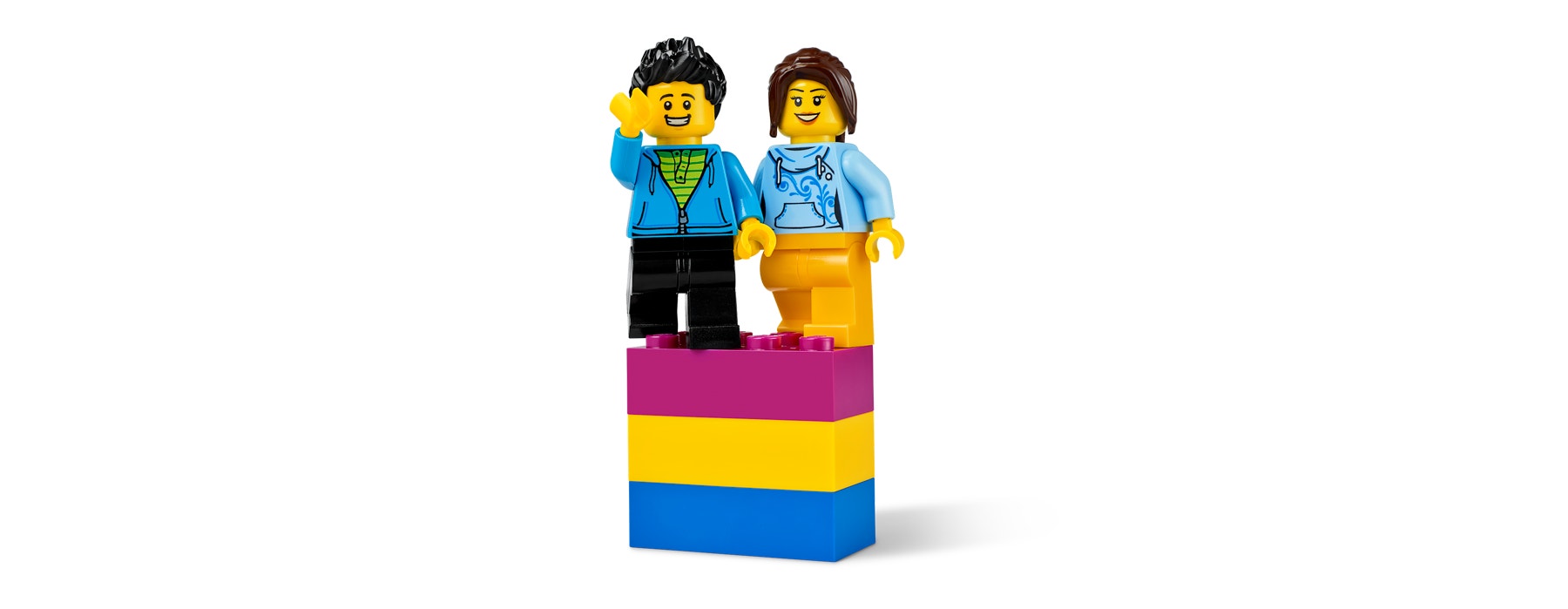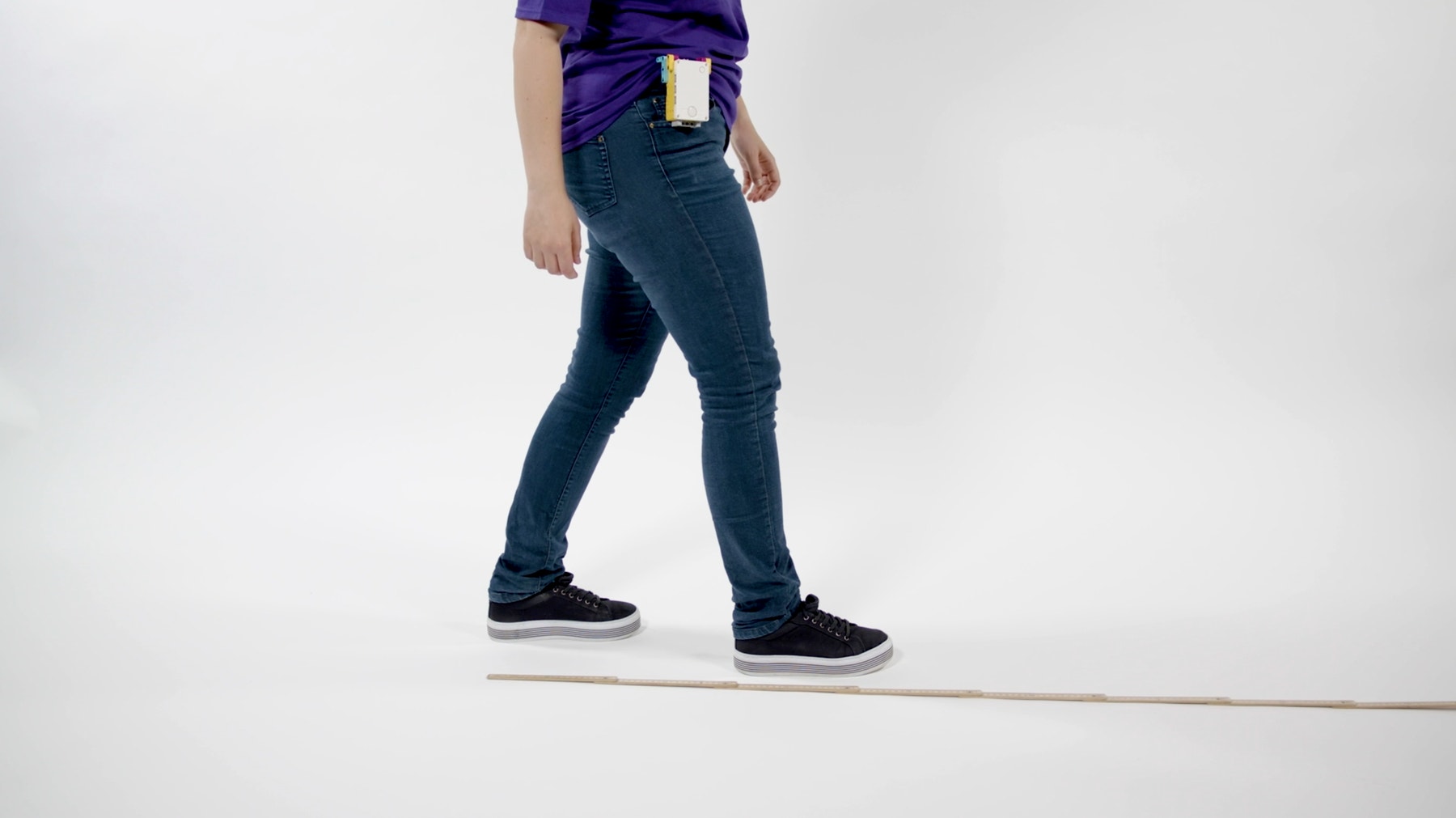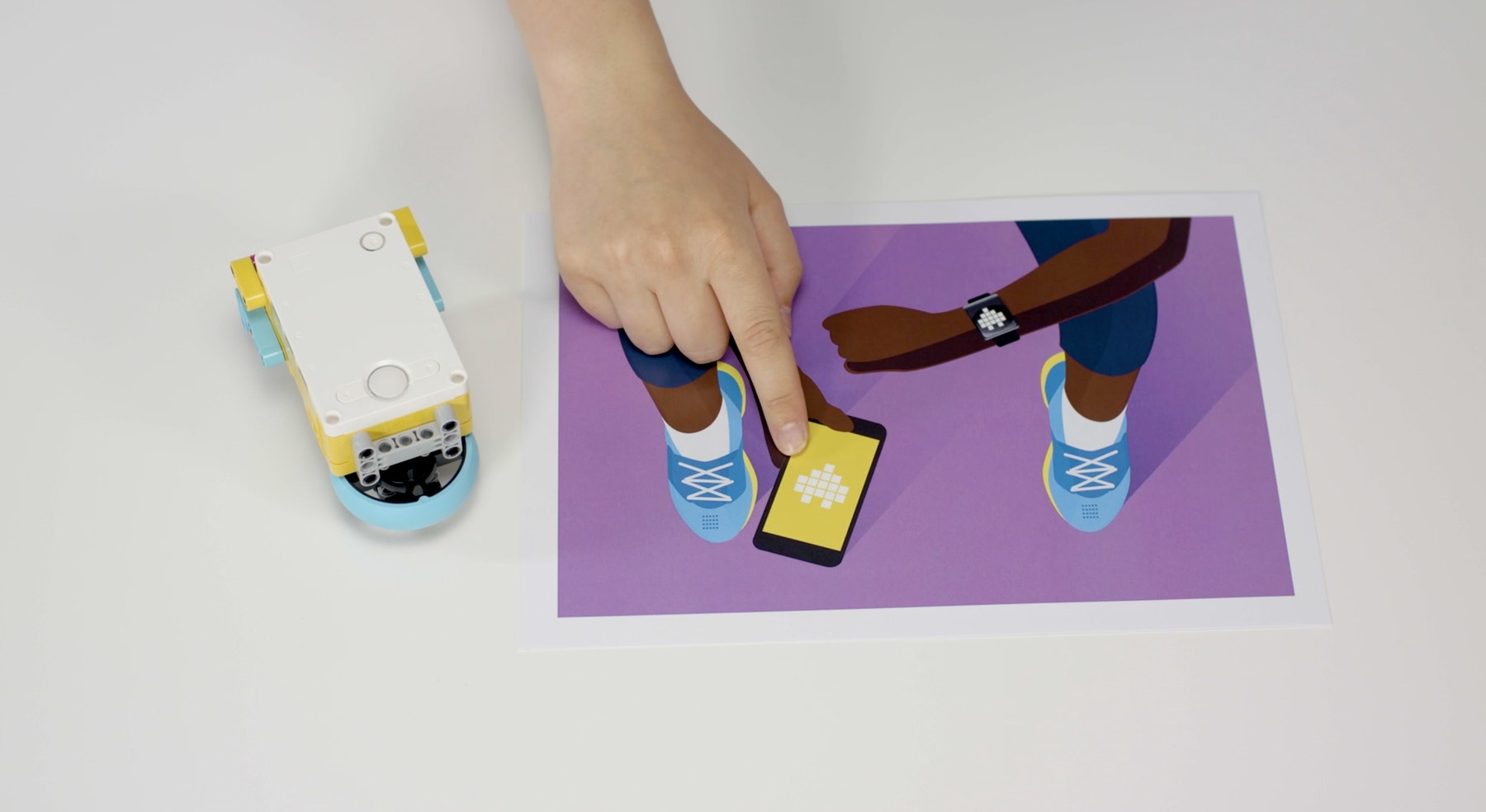Watch Your Steps
Explore kinetic energy during a movement at constant speed.

Engage
(Before the Lesson, 20 Min.)
This lesson explores the kinetic energy of a person who’s walking at a constant speed. Your pupils will start by measuring the number of steps they've taken. They'll use that value to calculate the distance that’s been travelled, the average walking speed and average kinetic energy value for that motion. The Hub has an internal accelerometer that can detect movement on the 3 axes (i.e. up-down, left-right, front-back). When the Hub is clipped to someone's hip, it moves as they walk and records acceleration values. The resulting graph shows the minimum and maximum values of the recorded acceleration values. The precision of these minimum and maximum values will depend on the vertical position of the Hub while the person is walking. The ‘step count’ precision will depend on the quality of these minimum and maximum values, and the calibrating values that have been used in the program.
Use various materials to engage your pupils on the topic of kinetic energy.
Ignite a Discussion
Start a discussion by asking questions related to the lesson. Here are a few suggestions:
- How can you measure how fast you're walking?
- How can you measure or calculate the energy of an object in motion?
- Which type of energy is that?
Have your pupils write down their thoughts as a hypothesis.
Explore
(During the Lesson, 30 Min.)
- Have your pupils build a pedometer that can count the number of steps they’ve taken. They can create their own models or follow the building instructions in the app to build the Pedometer model.
- Ask your pupils to try out their models using the suggested program.
- Tell them to look at the graph of acceleration over time and describe what a ‘step’ is.
Explain
(During the Lesson, 15 Min.)
- Allow your pupils some time to adjust their programs to improve their performance.
- Encourage them to record as much data as possible during their experiments.
- Have them export their data as a CSV file so that they can manipulate it using other software if they wish.
Elaborate
(After the Lesson, 25 Min.)
- If your pupils still have access to their SPIKE Prime Sets, have them complete the tasks given in the SPIKE App. This will help them to elaborate on their learning with a bit of hands-on activity. Here are some examples:
- Ask them to illustrate their kinetic energy as they walk or as part of their program. As one option, they can program the docking station to accomplish this task.
- If your pupils don't have access to their sets, have them complete their Inventor Notebooks, or assign one of the extension activities that’s been suggested below. Most of the extension activities can be done using the data that was collected during the hands-on session
- Facilitate a sharing session in which your pupils exchange information. This can be done using whichever method/tool is the most efficient (i.e. in-person or online).
Evaluate
- Give feedback on each pupil's performance.
- To simplify the process, you can use the assessment rubrics that have been provided.
Assessment Opportunities
Teacher Observation Checklist
Establish a scale that suits your needs, for example:
Partially accomplished
Fully accomplished
Overachieved
Use the following success criteria to evaluate your pupils' progress:
- The pupils are able to program a device that logs data on a line graph.
- The pupils are able to interpret the values coming from the line graph.
- The pupils can explain kinetic energy in relation to speed.
Self-Assessment
Have each pupil choose the brick that they feel best represents their performance.
- Blue: I’m able to graph data using the program that’s been provided in the app.
- Yellow: I’m able to create my own line graph and explain my results.
- Violet: I've created new experiments on my own.
Peer Feedback
Encourage your pupils to provide feedback to one another by:
Having one pupil use the coloured brick scale above to score another pupil’s performance.
Asking them to present constructive feedback to one another so that they can improve their group’s performance during the next lesson. This is an excellent opportunity to use videoconferencing tools or blog posting tools in a blended learning scenario.

Differentiation
Simplify this lesson by:
- Asking your pupils to recreate the experiment using only the Hub. The data should be relevant for counting steps as long as the Hub is held perpendicular to the ground.
Take this lesson to the next level by:
- Asking your pupils to build their own pedometers
- Having your pupils repeat the experiment using a phone or a tablet as a pedometer, then comparing the results of both experiments
- This will require an app that can visualise the device's sensor values

Tips
Building Tips

Coding Tips
This lesson is designed to be played while the hub is connected through USB or Bluetooth. While connected, the data collected by the Hub is streamed directly to your device, and traced in real-time on the Line Graph.
Main Program

Solution Program

Science Data Tips
Here’s an example of the data your pupils can expect from this experiment.

Extensions
Maths Extension
To incorporate the development of maths skills:
- Ask your pupils to identify the elements of their experiments that required approximation. Tell them to keep in mind that step lengths aren't always consistent and that pedometers have a limited rate of success (i.e. they're precise within a margin of error).
- Have your pupils determine how an optimal graph of a person walking would look.
Note: This will require additional time.

Literacy Extension
To incorporate the development of literacy skills:
- Ask your pupils to research how smartwatches or smartphones count and record steps. Have them write a short explanation of how the technology works, including the percentage of error.
- Have your pupils explore how pattern recognition, from an AI point of view, helps these smart devices to detect steps.
Note: This will require additional time.

Career Links
The pupils who enjoyed this lesson might be interested in exploring these career pathways:
- Therapeutic Services
- Engineering & Technology
Teacher Support
Pupils will:
• Learn to recognise the number of steps that have been taken, as shown in an acceleration graph over time
• Convert a step count into the average speed and average kinetic energy when walking
LEGO® Education SPIKE™ Prime Set
Device with the LEGO Education SPIKE App installed
DFE Science Programmes of Study KS3
Experimental skills and investigations - 3
• select, plan and carry out the most appropriate types of scientific enquiries to test predictions, including identifying independent, dependent and control variables, where appropriate
Experimental skills and investigations - 5
• make and record observations and measurements using a range of methods for different investigations; and evaluate the reliability of methods and suggest possible improvements
Changes in systems - 1
• energy as a quantity that can be quantified and calculated; the total energy has the same value before and after a change
Changes in systems - 3
• using physical processes and mechanisms, rather than energy, to explain the intermediate steps that bring about such changes.
DFE Maths Programmes of Study KS3
Reason mathematically - 1
• extend and formalise their knowledge of ratio and proportion in working with measures and geometry, and in formulating proportional relations algebraically
Ratio, proportion and rates of change - 7
• relate the language of ratios and the associated calculations to the arithmetic of fractions and to linear functions
Ratio, proportion and rates of change - 8
• solve problems involving percentage change, including: percentage increase, decrease and original value problems and simple interest in financial mathematics
Ratio, proportion and rates of change - 9
• solve problems involving direct and inverse proportion, including graphical and algebraic representations
DFE English Programmes of Study KS3
Writing - 1
Pupils should be taught to:
• write accurately, fluently, effectively and at length for pleasure and information through:
• writing for a wide range of purposes and audiences, including:
• summarising and organising material, and supporting ideas and arguments with any necessary factual detail
DFE Computing Programmes of Study KS3
Subject Content – 1
• design, use and evaluate computational abstractions that model the state and behaviour of real-world problems and physical systems
Subject Content – 3
• use two or more programming languages, at least one of which is textual, to solve a variety of computational problems; make appropriate use of data structures [for example, lists, tables or arrays];
Subject Content – 7
• undertake creative projects that involve selecting, using, and combining multiple applications, preferably across a range of devices, to achieve challenging goals, including collecting and analysing data and meeting the needs of known users
Subject Content – 8
• create, re-use, revise and re-purpose digital artefacts for a given audience, with attention to trustworthiness, design and usability
DFE Design & Tecnology Programmes of Study KS3
Design - 1
• use research and exploration, such as the study of different cultures, to identify and understand user needs
Design - 2
• identify and solve their own design problems and understand how to reformulate problems given to them
Design – 3
• develop specifications to inform the design of innovative, functional, appealing products that respond to needs in a variety of situations\*Design – 4*
• use a variety of approaches [for example, biomimicry and user-centred design], to generate creative ideas and avoid stereotypical responses
Design – 5
• develop and communicate design ideas using annotated sketches, detailed plans, 3-D and mathematical modelling, oral and digital presentations and computer-based tools
Evaluate - 3
• test, evaluate and refine their ideas and products against a specification, taking into account the views of intended users and other interested groups
Technical Knowledge - 4
• apply computing and use electronics to embed intelligence in products that respond to inputs [for example, sensors], and control outputs [for example, actuators], using programmable components [for example, microcontrollers].




